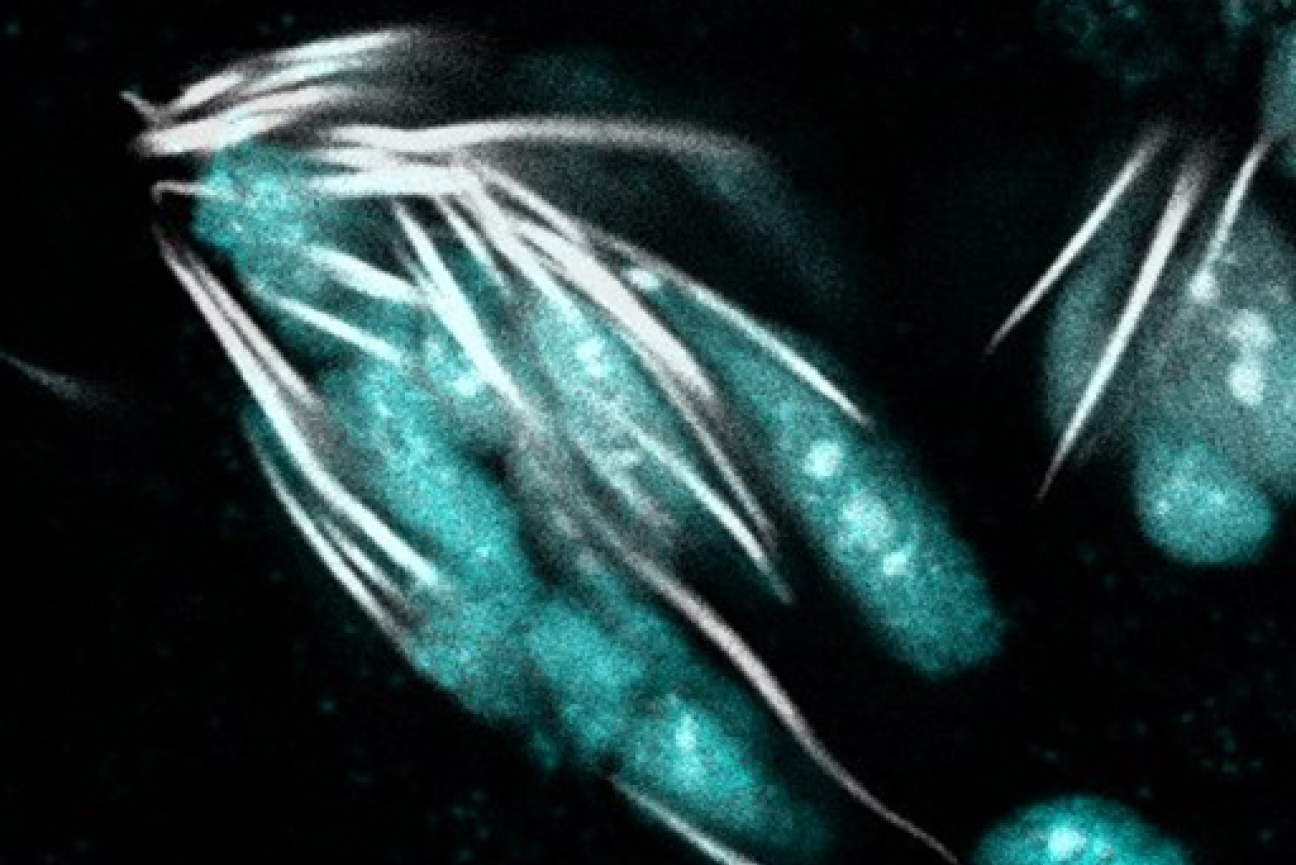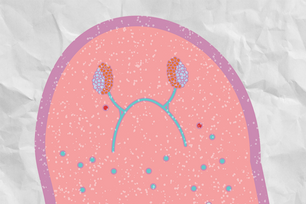
Developing sperm (in white) and developing sperm that have not compacted their DNA (in cyan)
Courtesy of Jun Park
Balance between proteins keeps sperm swimming swiftly
Sperm must swim swiftly to an egg in order to fertilize it, and so they have evolved hydrodynamic shapes. Most of the space in the head of sperm cells is taken up by the DNA they carry, so the cells coil up their DNA super tightly to stay small and streamlined. In most cell types, DNA is coiled around proteins called histones. These do not package DNA tightly enough for sperm, so when a sperm cell is developing, it swaps out histones for another type of protein called protamines that coil DNA very tightly.
Many species, including humans, mice, and flies, have multiple types of protamines. If the balance between the different types is wrong, then the sperm’s DNA may not be packaged correctly and it may become misshapen and die, making the animal infertile. Whitehead Institute Member Yukiko Yamashita and former graduate student Jun Park have discovered why this imbalance causes infertility in the fruit fly (Drosophila melanogaster). The finding, published in the Proceedings of the National Academy of Sciences on April 10, showed a mechanism that balances different types of protamines to ensure male fertility.
Mst77F is a major fruit fly protamine. Yamashita and Park determined that the fruit fly protamine Mst77Y, which is related to Mst77F, can interfere with the function of Mst77F. Fruit flies usually make a lot of Mst77F and a little of Mst77Y. The researchers found that when expression of the Mst77Y gene is too high, especially when expression of Mst77F is low, it disrupts the process of DNA packaging, leading to infertility.
How does Mst77Y interfere with Mst77F? The researchers discovered that this is because the Mst77Y gene makes faulty protamines. There are multiple copies of Mst77Y on the fly’s Y chromosome. They likely evolved from a copy of Mst77F, which is not on a sex chromosome. However, the different versions of Mst77Y have lost or altered parts that they need in order to function, so unlike the Mst77F protamine, Mst77Y protamines likely cannot coil DNA tightly around themselves. In spite of the fact that the Mst77Y protamines do not work correctly, they are dominant: when they are present, the sperm cell will use them over the functional Mst77F protamines.
“Mst77Y is a half-broken tool,” says Yamashita, who is also a professor of biology at the Massachusetts Institute of Technology and a Howard Hughes Medical Institute investigator. “It is able to take the place of the working tool, Mst77F, but not to do its job, so when too much Mst77Y is present, the sperm cell does not have enough working tools in place to compact its DNA.”
The researchers also figured out how sperm cells keep expression of Mst77F high and Mst77Y low: with the help of a protein called Modulo. In order for an RNA read from a gene to be made into a protein, it needs to have a tail added to it made up of a string of adenines—one of the four building blocks that make up RNA. Modulo makes sure that the cell preferentially adds this tail to the RNA coding for Mst77F. Although Yamashita and Park did not determine the exact mechanism by which Modulo ensures this preferential treatment, they did observe that Modulo and the Mst77F RNA group together in the same part of the cell, the nucleolus, whereas Mst77Y does not.
Altogether, these findings explain why and how fruit fly sperm cells carefully balance the levels of these two protamines. However, the research raises the question, what are sperm cells using the non-functional Mst77Y protamines for? Yamashita and Park can only speculate, but the answer may have to do with their observation that high levels of Mst77Y killed off more X-chromosome bearing sperm than Y-chromosome bearing sperm. Past research has suggested that protamines may be involved in a process called meiotic drive, which animals can use to skew the sex ratio of their offspring. This new work is not only consistent with that hypothesis, but provides a possible mechanism to explain how protamines contribute. The researchers note that they did not see a strong effect on the sex ratio of offspring in this experiment, but hope that this work could set the stage to understand the role of non-functional protamines in meiotic drive.
“At the cell level, we were able to show that there’s some basis for this protamine to be involved in biasing whether X or Y chromosome bearing sperm survive,” Park says. “An interesting next question would be to see if there are certain conditions in which this mechanism more clearly acts as a driver at the level of offspring’s sex ratio.”
Park, Jun I., George W. Bell, and Yukiko M. Yamashita. 2023. "Derepression of Y-linked multicopy protamine-like genes interferes with sperm nuclear compaction in D. melanogaster," PNAS 120 (16). https://www.pnas.org/doi/10.1073/pnas.2220576120
Contact
Communications and Public Affairs
Phone: 617-452-4630
Email: newsroom@wi.mit.edu


